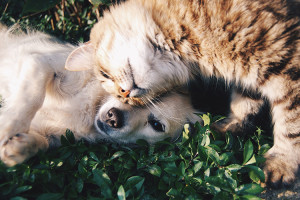
Oh, how things change… I remember, growing up, the family dog slept outside in a dog house. Today, over 62% of our pets share our bed. Our pets are now considered part of the family and we hold great emotional ties to them. Jump on a plane and you might see a companion pet in the seat next to you. Go shopping at Nordstrom and you might be sharing the aisle with a four-legged friend. This Thanksgiving, you may be making plans to curl up on the couch to watch the annual National Dog Show on TV with your favorite canine companion. Why? There are many theories on why our pets are now so woven into our lives. I share the theory that, in today’s world where stress is high, work is demanding, and news headlines talk of division and cruelty, our pets offer something that is most difficult to find – unconditional love and dedication.
There is no better example than a pooch named Arthur. If you have a few minutes, take a look at this following inspiring and heartwarming “dog story” from ESPN.
According to the American Pet Products Association, the pet industry has surpassed a whopping $63 billion in spending. 65% of our households own a pet, which is an increase of 10% from 12 short years ago. These are astonishing numbers that increase every year.
What does this all mean? The average annual cost of owning a pet can be in excess of $2,000, and that is without complications. Additionally, our love affair with our pets is translating into astronomical increases in veterinary spending. Statistics from the American Veterinary Medical Association (AVMA) reveal that in 2016 pet owners spent over $44 million dollars taking their animals to the vet. Costs for some procedures rival that of healthcare. Common ailments such as joint injuries in dogs can cost around $3,480. Removal of foreign objects ingested can average $1,755. Cancer, which is diagnosed in 12 million pets annually, will set an owner back an average of $2,033. However, if an animal is injured or killed due to veterinarian malpractice, the same animal its owners spent thousands of dollars on for treatment is considered almost worthless.
We all know the state of medical malpractice in healthcare, but what happens when something goes wrong with the treatment of your beloved pet? Currently, the majority of courts view pets as personal property and restrict damages to their market value replacement cost, even in the event of proven wrongful death. Until the mid-part of the last century, the term "malpractice" did not even apply to veterinarians (and still does not in some states where the profession is not listed under the malpractice statute). Recently, however, veterinarians have become subject to state malpractice actions. As the value of animals subject to malpractice actions increases from the traditional "market value" approach, it is expected that the number of malpractice claims will increase. To date, most animal medical malpractice cases are settled outside of court and few have won big settlements or verdicts.
Will the law change? The AVMA is set against any change in the law. It threatens rising costs if the law is changed. As to malpractice costs, the AVMA doesn’t collect statistics on veterinarian malpractice suits. The group’s associated Professional Liability Insurance Trust, or PLIT, which offers malpractice insurance for vets, does not release numbers or costs. The mere fact that consumers are spending so much on pet care is directly related to the frustration caused by the absence of equal payment in the event that medical malpractice is sustained. This is the driving force for change in the industry.
There is a growing trend in many states to view animals in a more realistic light and, in response, the veterinary industry is at a crossroads in instituting good risk management. As you can see from the past, there was little financial incentive to engagement of loss prevention and reduction principles. Yet, over the last 20 years, there have been random cases of veterinarian malpractice verdicts and settlements ranging from $10,000 to $75,000. The frequency of cases being brought and those cases resulting in appreciable values is on the rise. A recent case found a court awarding $39,000 for a companion dog after its owner was originally offered a $400 settlement. States such as Florida and Texas are two examples were the law and courts are changing to view pets as more than personal property.
From my personal experience, the number one takeaway in considering veterinary risk management practices is acknowledgment of a failure in the therapeutic undertaking – whatever the cause. Take the example from the progression of risk management and bioethics: disclose and empathize, apologize that the outcome was not as expected. Veterinarians, like healthcare professionals, do not study long and hard and invest energy and resources in developing their practices because they want to do harm; their goal is to help, and when the outcome disappoints, whether because of human error or “fate,” share the experience as one human to another, acknowledging the pain of loss. Empathy and compassion can go a very long way to reduce total loss costs.
In the end, consumers should do the same homework as in any healthcare situation. Research your providers and be aggressive in asking questions. Don’t be afraid to ask for a second opinion. One area that is key is care after surgery. While your surgeon may be the best, the quality of care from technicians after surgery is important to successful recovery. Remember, your pet can’t tell anyone if something is not right!
Tim Over, SVP, Specialty Operations